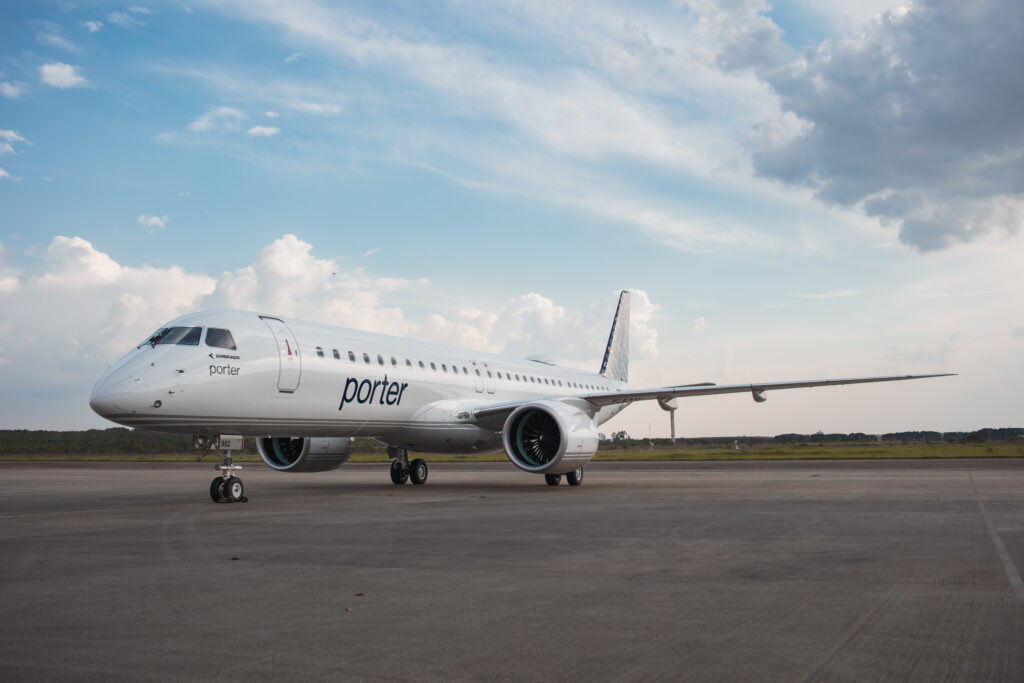Porter Aviation Holdings Inc. (PAHI), the parent company of Porter Airlines, has seen the opening of a new multi-million dollar maintenance base.
Together with Ottawa International Airport Authority (OIAA), they celebrated the grand opening of a major development at YOW – Porter’s new aircraft hangars and maintenance facility.
Ottawa Hub as Primary Maintenance Base
Spanning a combined 150,000 sq. ft., the two hangars will serve Porter’s expanding fleet, including the new Embraer E195-E2 jets and the existing De Havilland Dash 8-400 turboprops.
With 33 E195-E2s already operational and up to 100 on order, alongside their 29 Dash 8-400s, Porter is well-positioned for growth.
This significant investment, totaling $125 million, underlines a shared commitment to YOW’s future. OIAA constructed a new taxiway and related infrastructure to support the hangar development.

YOW will become a primary maintenance base for Porter, creating 200 local jobs.
These highly skilled roles include 160 Aircraft Maintenance Engineers (AMEs) along with shop technicians, stores clerks, and administrative staff.
“Porter’s presence at YOW has grown significantly in the past year. It includes new non-stop routes using both our E195s and Dash 8s. We plan to add an E195-E2 crew base at the airport,” said Michael Deluce, CEO, PAHI.
Mark Laroche, president and CEO, OIAA outlined the regional benefits of the new facility. “Porter Airlines’ commitment to YOW is transformational for Canada’s Capital Region, and the community will reap the economic and social benefits for decades.”
Developing a Skilled Workforce
To ensure a pipeline of qualified talent, Porter and Algonquin College are establishing a strategic partnership.
This collaboration will focus on work-integrated learning opportunities, program development, and training specifically tailored to the needs of the Ottawa hangars.
Programs like Aircraft Maintenance Technician and Aviation Management at Algonquin College will directly benefit from this partnership.
This initiative aligns perfectly with the growing demands of the aviation industry and demonstrates a commitment to fostering future aviation professionals.

Ottawa: A Fast Growing Market
Ottawa is Porter’s fastest-growing market outside of Toronto. This strategic location strengthens their Eastern Canada network while offering connections to their expanding western markets.
This summer, Porter will become the leading carrier at YOW, offering 16 non-stop routes and transporting an estimated two million passengers in 2024.
By year’s end, Porter’s Ottawa team is expected to grow to over 400. This will encompass customer service, pilots, flight attendants, and maintenance personnel.

New Hangar Facility: Key Features
The new hangars showcase a commitment to both innovation and sustainability. OIAA’s $15 million investment in Taxiway Romeo marks the first airside expansion project in the airport’s 20-year history.
This new taxiway ably supports Porter’s development. It also caters to future federal government needs and broader commercial aviation growth.
The hangars themselves are designed with sustainability in mind. Here are some key features:
- Electric Ground Support: A predominantly electric fleet of vehicles will be used for towing, servicing aircraft, and ground support operations.
- Energy Efficiency: The design exceeds current energy efficiency standards for insulation, heating, ventilation, air conditioning, lighting, and electrical systems.
- Sustainable Materials: Insulated Metal Panels (IMPs) with a lifespan exceeding 60 years are used. The cladding has a low embodied carbon footprint. Additionally, the steel used is 35% recycled and fully recyclable at the end of its lifespan.
- Water Management: A sophisticated fire protection system combines a conventional sprinkler system with an instantaneous foam deluge system. Additionally, a dedicated onsite water storage tank supplements the city hydrant system.
- Stormwater Management: Two underground tanks capture excess rainwater to prevent strain on the city’s main system.

Click the banner to subscribe to our weekly newsleter.

Click the photo to join our WhatsApp channel so then you can stay up to date with everything going on in the aviation industry!









